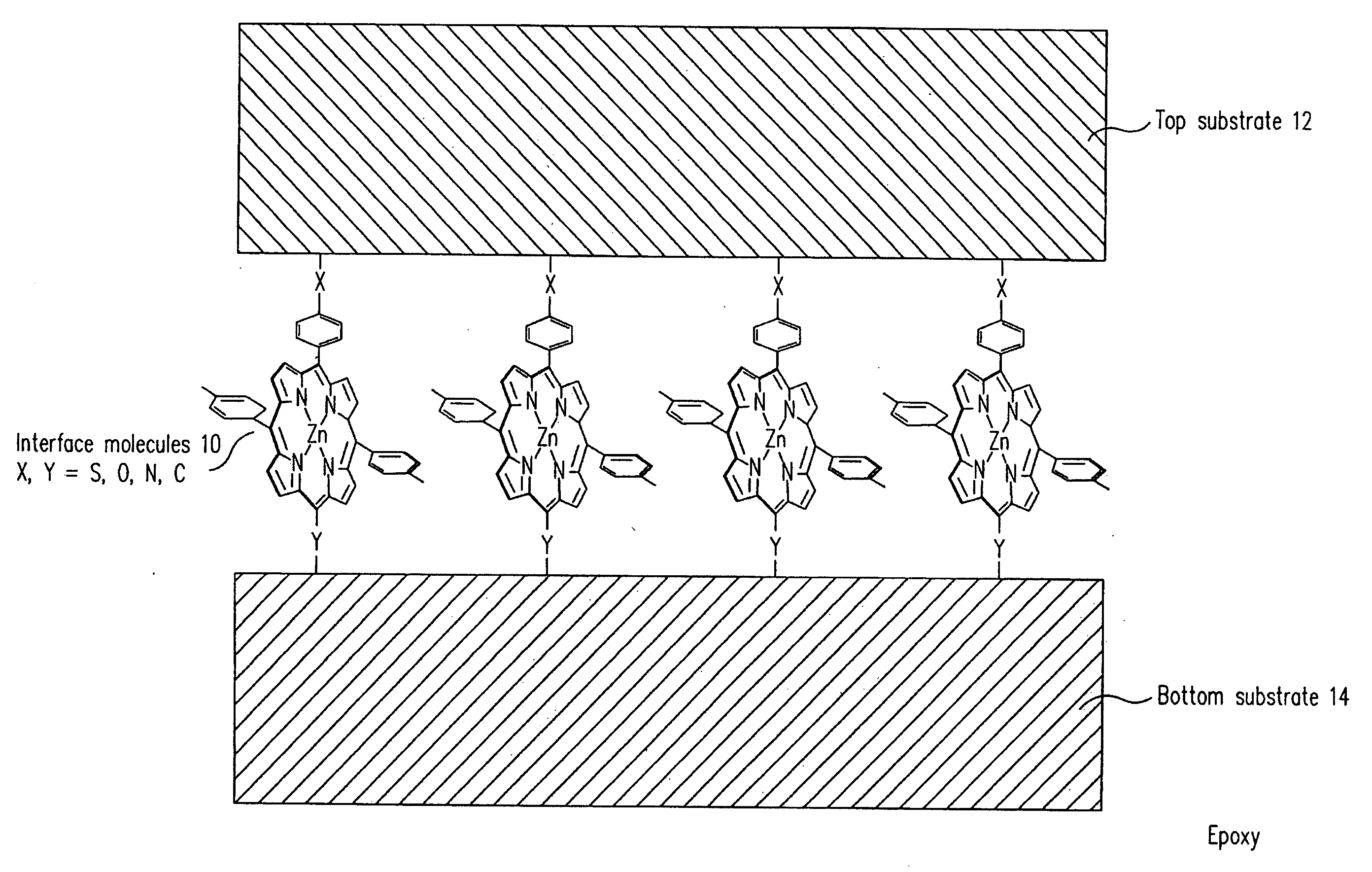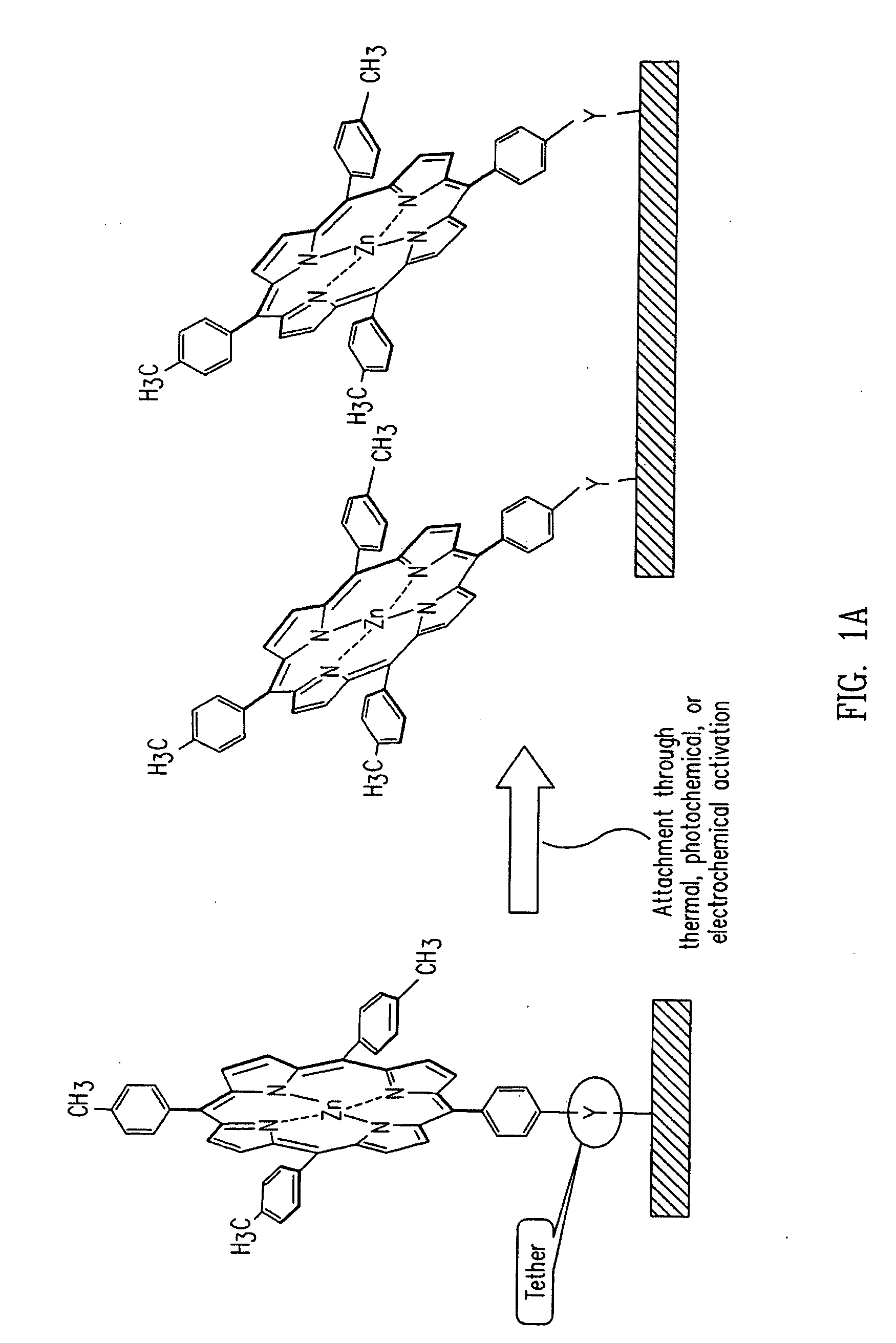Methods of Treating a Surface to Promote Binding of Molecule(s) of Interest, Coatings and Devices Formed Therefrom
- Summary
- Abstract
- Description
- Claims
- Application Information
AI Technical Summary
Benefits of technology
Problems solved by technology
Method used
Image
Examples
example 1
Molecule Attachment on a Metal Substrate
[0163]This example illustrates one exemplary approach to form a layer of organic molecules on a metal substrate. In this instance, a thiol-linker molecule 16 shown in FIG. 3, is attached to copper surface via the formation of C—S—Cu bond, as illustrated in FIGS. 1A and 2. A commercial copper wafer substrate was first cleaned by sonication for 5 minutes in acetone, water and then isopropyl alcohol. The substrate was coated with a solution containing 1 mM of the porphyrin molecule in ethanol by spin-coating. The sample was then baked at 150° C. for 5 minutes and followed by solvent rinse to remove the residual unreacted molecules. The amount of molecule attached can be adjusted by varying the concentration of the molecule, the attachment temperature, and duration, and quantified by Cyclic Voltammetry (CV) shown in FIG. 4, which is based on the redox property of porphyrin molecule as described in (Roth, K. M., Gryko, D. T. Clausen, C. Li, J., Lin...
example 2
Molecule Attachment on Semiconductor Substrates
[0164]This example illustrates another exemplary approach to form a layer of organic molecules on semiconductor substrates (SS): (a) Si, (b) TiN, (c) TiW, and (d) WN. In this instance; a hydroxy-linker molecule 1006 is attached to semiconductor surface via the formation of C—O—SS bond. Commercial semiconductor wafer substrates were first cleaned by sonication for 5 minutes in acetone, water, and then isopropyl alcohol. The substrates were coated with a solution containing 1 mM of the porphyrin molecule in benzonitrile by spin-coating. The sample was then baked at 350° C. for 5 minutes and followed by solvent rinse to remove the residual unreacted molecules. As illustrated in FIG. 5, the attachment of a molecular layer on each substrate is demonstrated again by the porphyrin CV signature peaks.
example 3
Molecule Attachment on Semiconductor Barrier Substrates
[0165]This example illustrates another exemplary approach to form a layer of organic molecules on semiconductor barrier substrates (BS) Ta and TaN. In this instance, a hydroxy-linker molecule 258 is attached to semiconductor surface via the formation of C—O—BM bond. Commercial barrier wafer substrates were first cleaned by sonication for 5 minutes in acetone, water, and then isopropyl alcohol. The substrates were coated with a solution, containing 1 mM of the porphyrin molecule in benzonitrile by spin-coating. The sample was then baked at 350° C. for 5 minutes and followed by solvent rinse to remove the residual unreacted molecules. In this case, the molecular layer formed can not be characterized by CV since the barrier substrates are electrically poorly conductive. The molecular layer was characterized by Laser Desorption Time-of-Flight Mass Spectroscopy (LDTOF) instead. FIG. 6 shows; exemplary LDTOF spectra that match the sta...
PUM
| Property | Measurement | Unit |
|---|---|---|
| Temperature | aaaaa | aaaaa |
| Temperature | aaaaa | aaaaa |
| Temperature | aaaaa | aaaaa |
Abstract
Description
Claims
Application Information
 Login to View More
Login to View More - R&D
- Intellectual Property
- Life Sciences
- Materials
- Tech Scout
- Unparalleled Data Quality
- Higher Quality Content
- 60% Fewer Hallucinations
Browse by: Latest US Patents, China's latest patents, Technical Efficacy Thesaurus, Application Domain, Technology Topic, Popular Technical Reports.
© 2025 PatSnap. All rights reserved.Legal|Privacy policy|Modern Slavery Act Transparency Statement|Sitemap|About US| Contact US: help@patsnap.com



